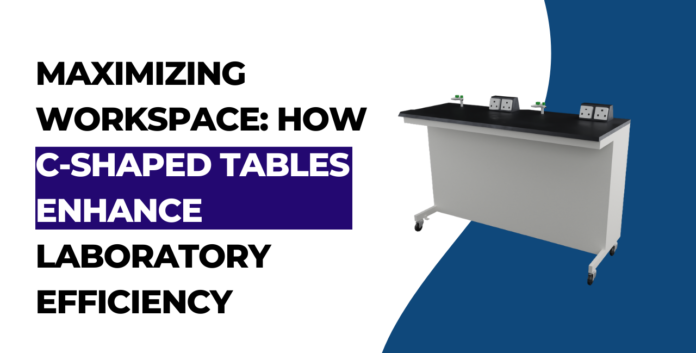Laboratories are the backbone of scientific research and development, playing a crucial role in innovation across numerous fields. With the constant evolution of technology and growth in research demands, optimizing workspace within laboratories has never been more essential.
Workspace optimization not only impacts the efficiency of research activities but also significantly contributes to the safety and well-being of lab personnel. Among the various strategies to achieve an optimized laboratory workspace, the introduction of C-shaped tables has been a game-changer. This blog post explores how C-shaped tables have enhanced laboratory efficiency, enabling a more productive, collaborative, and safe working environment.
Understanding the Concept of C-Shaped Tables
C-shaped tables are uniquely designed furniture pieces that, as the name suggests, form a ‘C’ shape. This design is tailored to fit around the user’s body, providing easy access to the work surface from a seated or standing position. In a laboratory setting, this ergonomic innovation allows scientists and researchers to work more comfortably and efficiently, with all necessary instruments and materials within easy reach.
Advantages of C-shaped Tables in Laboratory Settings
Enhanced Accessibility
One of the most significant benefits of C-shaped tables is the enhanced accessibility they provide. Researchers can easily move closer to their work area without the restrictions of conventional straight-edged tables. This design greatly benefits tasks that require precision and concentration, reducing strain and increasing comfort during long hours of work.
Improved Collaboration
The open structure of C-shaped tables encourages a more collaborative work environment. By facilitating easy communication and sharing of resources, these tables support teamwork and the exchange of ideas. This collaborative approach is vital in a lab setting, where innovation often results from collective brainstorming and experimentation.
Increased Workspace Efficiency
C-shaped tables have been shown to increase workspace efficiency dramatically. Their ergonomic design ensures that every inch of table space is easily accessible, reducing unnecessary movement and allowing for a more organized setup. Furthermore, their unique shape can accommodate more personnel around a single table without compromising comfort, making them an excellent choice for laboratories with limited space.
Design Considerations for C-shaped Tables
When integrating C-shaped tables into a laboratory, several design considerations should be taken into account:
Materials
The choice of material for C-shaped tables is crucial for durability and safety. Materials need to be resistant to chemicals, heat, and abrasion to withstand the rigorous demands of laboratory work.
Ergonomics
Ergonomics plays a vital role in the design of C-shaped tables. Adjustable height options and accessibility features ensure that the tables can cater to the needs of every user, promoting well-being and reducing the risk of work-related injuries.
Customization Options
The ability to customize C-shaped tables allows for a tailored approach to laboratory design. From the size and color to additional features like built-in storage or sink units, customization ensures that the tables meet the specific requirements of each laboratory.
Case Studies: Successful Implementation of C-shaped Tables in Laboratories
Several laboratories worldwide have successfully implemented C-shaped tables, realizing notable improvements in efficiency and researcher satisfaction. These case studies demonstrate the versatility and effectiveness of C-shaped tables in various research environments.
Maintenance and Durability of C-shaped Tables
C-shaped tables are designed to be low maintenance and durable, with materials and finishes that are easy to clean and resistant to the wear and tear of daily laboratory use. Regular maintenance ensures that these tables remain in optimal condition, providing a reliable workspace for years to come.
Cost Considerations and Return on Investment
While C-shaped tables may represent a higher initial investment than traditional laboratory tables, their benefits in terms of efficiency, safety, and durability translate into a significant return on investment. By facilitating a more productive and collaborative work environment, C-shaped tables can lead to greater scientific output and innovation.
Comparison with Other Laboratory Furniture Options
Compared to conventional laboratory furniture, C-shaped tables offer a unique combination of accessibility, comfort, and collaboration potential. While other furniture options may fulfill basic needs, C-shaped tables are specifically designed to enhance the laboratory workflow.
Future Trends in Laboratory Workspace Optimization
The trend towards more ergonomic and collaborative laboratory furniture is expected to continue, with C-shaped tables leading the way. Innovations in materials, technology integration, and sustainable design will further enhance the way laboratories are fitted out, making them more efficient, safe, and conducive to cutting-edge research.
Conclusion
C-shaped tables represent a significant advancement in laboratory design, offering a versatile solution that addresses the unique challenges of laboratory work. By enhancing accessibility, collaboration, and workspace efficiency, C-shaped tables contribute to a more productive and satisfying work environment. As laboratories continue to evolve, the adoption of innovative furniture designs like C-shaped tables will play a pivotal role in driving scientific advancement and discovery.





